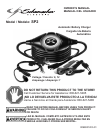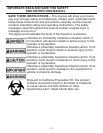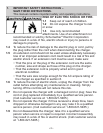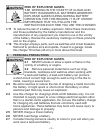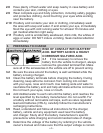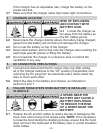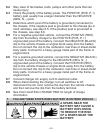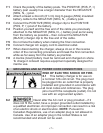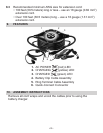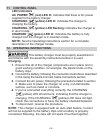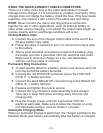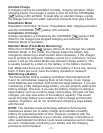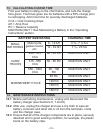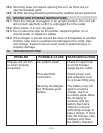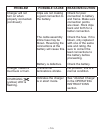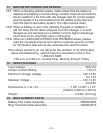
• 6 •
Stay clear of fan blades, belts, pulleys and other parts that can 6.2
cause injury.
Check the polarity of the battery posts. The POSITIVE (POS, P, +) 6.3
battery post usually has a larger diameter than the NEGATIVE
(NEG, N, -) post.
Determine which post of the battery is grounded (connected) to 6.4
the chassis. If the negative post is grounded to the chassis (as in
most vehicles), see step 6.5. If the positive post is grounded to
the chassis, see step 6.6.
For a negative-grounded vehicle, connect the POSITIVE (RED) 6.5
clip from the battery charger to the POSITIVE (POS, P, +)
ungrounded post of the battery. Connect the NEGATIVE (BLACK)
clip to the vehicle chassis or engine block away from the battery.
Do not connect the clip to the carburetor, fuel lines or sheet-metal
body parts. Connect to a heavy gauge metal part of the frame or
engine block.
For a positive-grounded vehicle, connect the NEGATIVE (BLACK) 6.6
clip from the battery charger to the NEGATIVE (NEG, N, -)
ungrounded post of the battery. Connect the POSITIVE (RED)
clip to the vehicle chassis or engine block away from the battery.
Do not connect the clip to the carburetor, fuel lines or sheet-metal
body parts. Connect to a heavy gauge metal part of the frame or
engine block.
Connect charger AC supply cord to electrical outlet.6.7
When disconnecting the charger, turn all switches to off, 6.8
disconnect the AC cord, remove the clip from the vehicle chassis
and then remove the clip from the battery terminal.
See CALCULATING CHARGE TIME for length of charge 6.9
information.
FOLLOW THESE STEPS WHEN BATTERY IS OUTSIDE VEHICLE7.
A SPARK NEAR THE
BATTERY MAY CAUSE A
BATTERY EXPLOSION.
TO REDUCE THE RISK
OF A SPARK NEAR THE
BATTERY:



